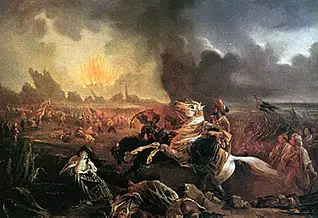Ancient Egyptian Battles
How powerful were the armies of Ancient Egypt?
The armies of Egypt were respected the world over for their discipline and training, but didn’t have much experience of warfare. Egypt was a historically peaceful nation, ruled over by a single pharaoh and government, and usually only ever fought to repel invaders.
Because of this, the country’s strategies were typically much more poorly developed than those of their European or Asian neighbors.

Egyptian soldiers trained with all sorts of different weapons (swords, knives, spears, bows) and their position in the army would be decided by which they were best with. For example, if they were good at using a bow, they would become an archer, or if they were skilled with a sword, they’d join the infantry.
This system meant that soldiers were always in the division that best suited their strengths; however, many would likely have trained hardest to become archers, as it was a safer position in wartime than being on the frontlines.
Egyptian soldiers began combat training when they were as young as five, though they weren’t actually allowed to fight until they were 20, and trained regularly to keep up their strength. Because the Ancient Egyptians only wore leather armor, the soldiers were trained extensively for speed, so they could avoid being stabbed or killed.
What were some of the most famous Egyptian battles?
One of the most famous examples of an Egyptian battle is The Battle of Megiddo, which was fought in 1479 BC. The Battle of Megiddo is significant because it was one of the first documented battles in history.
It was fought after the pharaoh Thutmose III came to power following his mother Hatsheput’s death.
During her reign, Hatshepsut commanded a powerful army, which became Thutmose’s following his ascension to the position of pharaoh.
Some Egyptians (collectively called the Canaanites of Megiddo) believed him to be a weak leader, and organized a rebellion against him. Using his force of 20,000 men, Thutmose III repelled the invading forces of Megiddo and laid their cities under a seven-month siege.
He emerged victorious and spent the rest of his reign consolidating his power in the regions which had once rebelled against him.
Battle of Kadesh
About two hundred years later (in 1274 BC), the Battle of Kadesh was fought between Ramesses II’s army and the Hittites of Anatolia (now known as Turkey.)
This battle resulted from Ramesses’ aggressive policy of expansion into Syria; by overstepping the Anatolian border, his army attracted the attention of the powerful Hittites.
Shortly afterward, the two clashed for control of Kadesh, a city of great strategic importance to the Syrian invasion.
This battle has been labeled as a ‘draw’ by many historians: though Ramesses II had fewer troops, his army won the battle, but afterward failed to conquer the city they’d come for.
Similarly, although the Hittites failed to win the day, they succeeded in protecting their city from Egyptian conquest.
In 1258 BC, the Hittites and Egyptians signed the world’s first-ever peace treaty, and a productive trading environment was established between their two nations.
Battle of Pelusium
The Battle of Pelusium was fought between Pharaoh Psametik III’s Egyptian army and the First Persian Empire in 526 BC.
The battle was sparked by a failed arranged marriage between the pharaoh’s daughter and the ruler of Persia.
When another girl was sent instead of the pharaoh’s daughter, the Persians grew extremely angry and attacked Egypt to get revenge.
Though the Egyptians armies were well-trained, the Persians used their superior military tactics to win.
Part of this involved using the Egyptians’ faith against them: when the Persian soldiers attacked, they had cats strapped to their chests and shields.
Because cats were a sacred animal of Egypt (the cat goddess Bast was worshipped across the land), the soldiers wouldn’t be able to attack their enemies, for fear that their souls would be damned in the afterlife.
In the Battle of Pelusium, the Persian soldiers lost only 7,000 men to the Egyptians’ 50,000, a spectacular failure for the Pharaoh’s army.
The Battle of Pelusium was a key factor in the collapse of the Egyptian Empire, and saw the country annexed (controlled) by the Persians until the arrival and re-conquering of the country by Alexander the Great two centuries later.
Facts about Ancient Egyptian Battles:
- The armies of Egypt were respected the world over for their discipline and training, but didn’t have much experience of warfare.
- Egypt was a historically peaceful nation, ruled over by a single pharaoh and government, and its soldiers didn’t get a chance to fight as often as those of other nations.
- Egyptian soldiers began combat training when they were as young as five, though they weren’t allowed to fight until they were 20
- Egyptian soldiers trained with all sorts of different weapons (swords, knives, spears, bows) and their position in the army would be decided by which they were best with.
- One of the most famous examples of an Egyptian battle is The Battle of Megiddo, which was fought in 1479 BC.
- The Battle of Megiddo is significant because it was one of the first documented battles in history
- About two hundred years later (in 1274 BC), the Battle of Kadesh was fought between Ramesses II’s army and the Hittites of Anatolia (now known as Turkey.)
- his battle resulted from Ramesses’ aggressive policy of expansion into Syria; by overstepping the Anatolian border, his army attracted the attention of the powerful Hittites.
- Following a battlefield draw, in 1258 BC, the Hittites and Egyptians signed the world’s first-ever peace treaty, and a productive trading environment was established between their two nations.
- The Battle of Pelusium was fought between Pharaoh Psametik III’s Egyptian army and the First Persian Empire in 526 BC.
- The battle was sparked by a failed arranged marriage between the pharaoh’s daughter and the ruler of Persia.
- The Battle of Pelusium was a key factor in the collapse of the Egyptian Empire, and saw the country annexed (controlled) by the Persians until the arrival and re-conquering of the country by Alexander the Great two centuries later.
QUESTIONS:
- Which Egyptian battle is one of the first-ever battles documented in history?
The Battle of Megiddo.
- Who was the pharaoh at the time of the Battle of Kadesh?
Ramesses II.
- What was the name of the country the Hittites came from?
(Nowadays, it’s called Turkey.)
- Who won the Battle of Pelusium?
The First Persian Empire.
- Why was the Egyptian army less practiced than those of other countries?
The country was generally peaceful, and because the position of the pharaoh was rarely claimed through violent revolt, it was relatively free of civil warfare.



